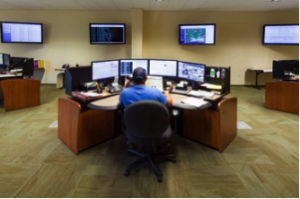By Karen Kaley, CCC, Cotton Electric Cooperative

It was midnight when a six-note tumbling chime jarred me awake last night. I knew that sound at that hour meant someone in my family or my employer needed me. I took a deep, sleepy breath, opened one eye and pulled the now-blinking cell phone off the nightstand.
It was a text message from the co-op’s outage messenger. Our system sends messages to certain employees when outages reach a certain level. As a communicator, I am one of the lucky ones.
There are two CCCs at Cotton Electric Cooperative in southwest Oklahoma and we both receive these messages. We rotate responsibility for after-hours communications on a weekly basis. My oh-so-helpful phone told me it was my week.
I stayed in bed a moment longer, trying to clear my head and consider the message. The system was predicting an outage affecting 222 members. If it were so, more chiming messages would follow as more information was entered into the system.
I roused myself a bit more, found the browser on my phone, and went to the co-op’s website, then the outage map. Yep, there was a big red blotch, still listed as unverified.
If truly there was an outage that size, I knew several things were happening. Our night dispatcher was fielding many phone calls. His computer was pinging with outages being reported through SmartHub apps on members’ phones. And some of those 222 members were hitting our Facebook page, looking for information.
I found a pen and paper before switching to yet another app: Phone. I scrolled through the Contacts and tapped the listing for the direct line to our dispatcher.
I listened to the phone ring and ring, and worried that I was adding to the dispatcher’s workload. But I knew that taking a few minutes of the dispatcher’s time could translate into fewer phone calls once I got an update posted. I knew that posting that information would appease members sitting in the dark, looking us up on fully-charged cell phones.
I knew members would be looking for three things: That we were aware of the outage, a crew was on the way and an estimate of when power would be restored.
That last one is tricky.
At the beginning of an outage, when cause is still unknown, it is nearly impossible to predict how long it will last, but our always-on age of the Internet subjects us to that question before it can be answered. We use the phrase “as quickly as safety allows,” which usually will hold things in place until we get more information.
The dispatcher told me he didn’t think the outage was as big as the prediction and that he had a lineman going out to check the spot where an OCR had closed. I posted that we had a crew out investigating and went back to bed. My phone chimed one more time about 45 minutes later to confirm the crew was dispatched and was quiet for the rest of the night.
As it happens, last night’s outage affected only 15 members for an hour. Four members, nearly one-quarter of those affected, had called in. This was easy compared to the recent spring, where we had back-to-back wild storms for several weeks. Those were some long nights, but well worth it. The more information we posted, the more positive the response from our members.
Technology has seen to it that communicators play an important role during those times. We accomplish a lot with a few words, comforting anxious members and easing the burden for colleagues trying to coordinate efforts to restore power as quickly and as safely as possible.
The positive result of outage communication goes both ways. We field a lot of encouraging messages from our members: “Stay safe.” “Praying for the workers out in this mess.” “Thanks for all you do.” “Y’all rock!”
I don’t mind getting up in the middle of the night. I know our members and my colleagues appreciate it. Providing this service is one way I – and my trusty phone – contribute to the Cooperative Difference.
